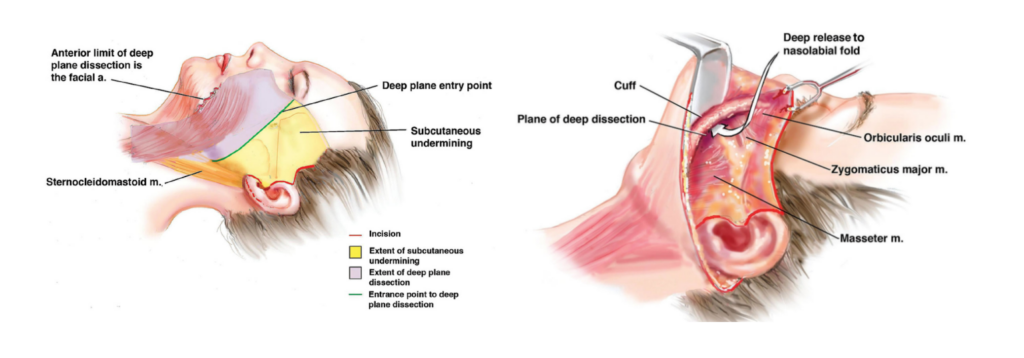How does a Deep Plane Facelift work?
Model featured in photography
Are you exploring facelift options? There are various types of facelifts available, and understanding the differences can help you consider which might best suit your needs. This information will focus on the deep plane facelift—what it entails and how it differs from other facelift techniques.
What is a Deep Plane Facelift?
A deep plane facelift is a specialised approach that addresses concerns commonly associated with the natural ageing process, such as changes in skin laxity, the appearance of deeper lines, and a reduction in facial volume. A consultation with a qualified professional is recommended to discuss your individual needs and options, as they can provide advice tailored to your goals and overall health considerations.
The Deep Plane Facelift Procedure
A deep plane facelift is a facelift technique that repositions both muscle and skin layers as a unified structure. Typically performed under general anaesthesia, the procedure duration is usually around two hours, depending on each patient’s unique circumstances.
The deep plane facelift typically begins with a carefully placed incision along the hairline, sometimes extending in front of the ear, providing access to deeper facial structures. Through this access point, the surgeon can gently reposition and adjust muscles and connective tissues. In some cases, this process may also involve removing small amounts of fat.
Once the deeper structures have been repositioned, the skin will be redraped over the newly positioned tissue, and any excess skin will be trimmed away. Stitches or surgical tape will be used to close the incisions.
For further information and personalised advice, consulting with a qualified healthcare provider is recommended to help you understand what to expect based on your individual needs.

Potential Advantages of a Deep Plane Facelift
- Avoiding a “Pulled” Look – By working with the foundational layers of the face, the deep plane technique is designed to targets the deeper layers of the skin, avoiding the overdone or pulled look.
- Volume Support – As part of the ageing process, facial volume may naturally diminish. This technique may support repositioning of tissues to potentially address these changes.
- Manageable Downtime – Depending on the patient’s unique situation, this approach may allow for a recovery period that accommodates same-day discharge.
Dr Jack Zoumaras is a highly skilled and experienced facial plastic surgeon in Australia with a focus on advanced facelift techniques, including the deep plane facelift. If you want to know more about deep plane facelift, a consultation with Dr Zoumaras can provide you with personalised information and insights tailored to your unique situation.
Disclaimer: At Artiste Plastic Surgery, our Plastic Surgeons led by Dr Jack Zoumaras have been trained to the highest possible degree. All surgery has risks and it is always advised to get a second opinion. Risks are very real and we cannot guarantee any result. Results are illustrated as a guide only. All risks are managed and any need for revision surgery or complications (1-5%) can be managed by our specialist plastic surgeons.
Any statements on how you will feel is based on Level V Evidence:
Level V: How you will feel after plastic surgery varies between individuals, depending on psychological and physical factors. Our internal research is based on how patients in our practice feel after surgery.
The blogs are not a substitute for a medical consultation and do not form as part of the doctor to patient relationship.
SHARE THIS ARTICLE
Aug27
What Men Need to Know About Facial Rejuvenation
Disclaimer: At Artiste Plastic Surgery, our Plastic Surgeons led by Dr Jack Zoumaras have been trained to the highest possible degree. All surgery has risks and it is always advised ...
Aug27
Signs You’re Ready for a Facelift
Disclaimer: At Artiste Plastic Surgery, our Plastic Surgeons led by Dr Jack Zoumaras have been trained to the highest possible degree. All surgery has risks and it is always advised ...
ABOUT ARTISTE
Artiste Plastic Surgery is an Award Winning Specialist Plastic Surgery practice led by internationally trained Dr. Jack Zoumaras, Plastic Surgeon and Peer Reviewed Face Surgeon
Artiste offers the latest Cosmetic Surgical Procedures of the Face, Breast and Body, inspired from leading centres around the world.
STAY IN THE LOOP
Enter your email address below to receive updates on new articles and VIP access to promotions and special offers.
FOLLOW US ON INSTAGRAM
